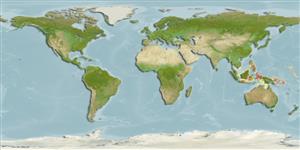>
Gobiiformes (Gobies) >
Gobiidae (Gobies) > Gobiinae
Etymology: Trimma: Greek, trimma, -atos = something crushed (Ref. 45335); habrum: Name from the Greek word ‘habros’, meaning delicate, dainty or graceful, referring to the soft and delicate shades of colour of freshly collected specimens.
More on author: Winterbottom.
Environment: milieu / Zona climática / intervalo de profundidade / distribution range
Ecologia
marinhas demersal; intervalo de profundidade 60 - 70 m (Ref. 90102). Tropical
Western Pacific Ocean: Indonesia.
Tamanho / Peso / Idade
Maturidade: Lm ? range ? - ? cm
Max length : 1.8 cm SL macho/indeterminado; (Ref. 87358)
Descrição suscinta
Chaves de identificação | Morfologia | Morfometria
Espinhos dorsais (total) : 7; Raios dorsais (total) : 8 - 9; Espinhos anais: 1; Raios anais : 8 - 9. This species is distinguished by the following characters: a bony interorbital width equal to the pupil diameter, predorsal midline with 8-9 scales; unbranched pectoral fin rays 14; an unbranched fifth pelvic fin ray; no basal membrane joining the fifth pelvic fin rays across the midline; usually a single full row of cheek scales; scales on the upper two-thirds of the opercle; when fresh, colouration is diagnostic - a pale translucent dorsum with light yellow blotches and the base of each element of the dorsal fin surrounded by a red spot, a thin red bar along the posterior margins of the hypurals, no dark pigment at all on the hypural region of the peduncle, and a darkly pigmented covering to the dorsal margins of the swim bladder, neural sheath, and the brain (Ref. 87358).
Body shape (shape guide): fusiform / normal; Cross section: compressed.
Inhabits vertical walls and deep reef in about 60-70 m (Ref. 90102).
Ciclo de vida ou comportamento de acasalamento
Maturidade | Reprodução | Desova | Ovos | Fecundidade | Larvas
Winterbottom, R., 2011. Six new species of the genus Trimma (Percomorpha; Gobiidae) from the Raja Ampat Islands, Indonesia, with notes on cephalic sensory papillae nomenclature. aqua, Int. J. Ichthyol. 17(3):127-162. (Ref. 87358)
Status na Lista Vermelha da UICN (Ref. 130435: Version 2024-2)
Ameaça para os humanos
Harmless
Uso pelos humanos
Pescarias: sem interesse
Ferramentas
Relatórios especiais
Baixar XML
Fontes da internet
Estimates based on models
Preferred temperature (Ref.
123201): 27.2 - 28.2, mean 27.8 °C (based on 7 cells).
Índice de diversidade filogenética (Ref.
82804): PD
50 = 0.5000 [Uniqueness, from 0.5 = low to 2.0 = high].
Bayesian length-weight: a=0.01023 (0.00477 - 0.02194), b=3.01 (2.83 - 3.19), in cm total length, based on LWR estimates for this (Sub)family-body shape (Ref.
93245).
Fishing Vulnerability (Ref.
59153): Low vulnerability (10 of 100).
🛈
